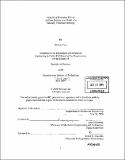Analysis of buoyancy driven airflow patterns in a model of a naturally ventilated building
Author(s)
Cain, Melissa, 1982-
DownloadFull printable version (1.266Mb)
Other Contributors
Massachusetts Institute of Technology. Dept. of Mechanical Engineering.
Advisor
Leon Glicksman.
Terms of use
Metadata
Show full item recordAbstract
Models can help us understand the climate conditions inside naturally ventilated buildings in order to improve the efficiency of the design. Naturally ventilated buildings use temperature gradients to create buoyancy forces in the space and drive the airflow pathways in the space. One architectural design feature that facilitates natural ventilation is the presence of stack ventilation in the roof of the building, which facilitates the expulsion of heated air from the space. An architectural feature that changes the airflow pathways is the presence of railing on the upper floors where there is a danger of falling into the atrium. Using the model of a naturally ventilated building located in the Building Technology Department at MIT airflow visualization studies were carried out using incense to view the airflow patterns in the model. The variables of temperature, size of stack ventilation opening, and whether there were railings in the building or not were varied to determine their effects on the airflow. Temperature had the effect of increasing the velocity of the airflow, but did not significantly change the overall airflow profile. The size of the stack vent opening changed the airflow pathways significantly as did adding railings into the model. Comparing the results with a computational fluid dynamics model shows that there are some discrepancies.
Description
Thesis (S.B.)--Massachusetts Institute of Technology, Dept. of Mechanical Engineering, 2004. Includes bibliographical references (leaf 22).
Date issued
2004Department
Massachusetts Institute of Technology. Department of Mechanical EngineeringPublisher
Massachusetts Institute of Technology
Keywords
Mechanical Engineering.